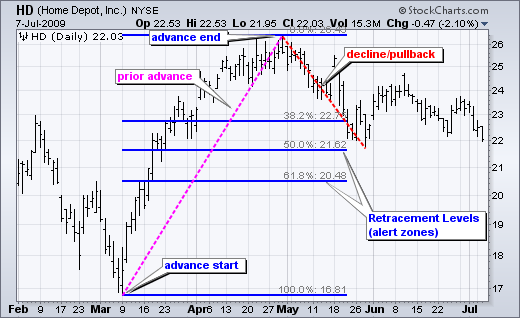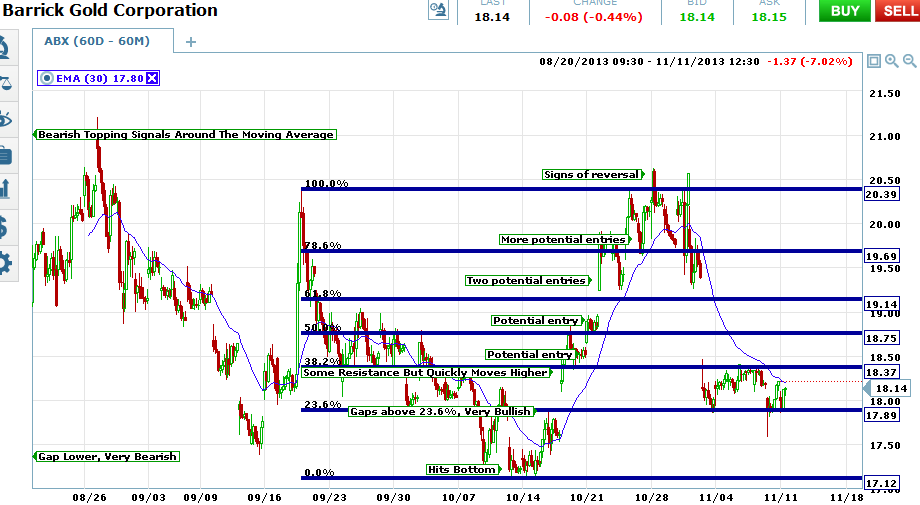Fibonacci Targets and Retracements
Post on: 29 Апрель, 2015 No Comment

The Fibonacci Sequence – A Formula For Natural Growth And Decay
In 1202, Fibonacci published his seminal work Liber Abaci (Book of the Abacus), which introduced Hindu-Arabic numerals and concepts, which set mathematics free from the abacus. This was the birth of modern mathematics which has allowed me to write this on my computer and for you to read it on yours! Fibonacci asked: If you place a male and a female rabbit in a hutch and they produce a new pair every month, how many rabbits would there be after a year (with no deaths, of course)?
This has given birth to the Fibonacci Sequence: 1, 1, 2, 3, 5, 8, 13, 21, 34, 55, 89, etc. Interestingly, the ratio of a number to the one just before it approached 1.618. And amazingly, its inverse is 0.618. This works from any starting point! The ratio has become known as the Golden Ratio, or phi . and is considered the most beautiful of proportions in art and architecture (the Greeks and Romans used it extensively). It is the ratio that expresses growth (or decay) in nature and that is important for market behaviour.
Growth in nature (rising markets) is expressed by 1.618 and 1.618 2 ( = 2.618). Decay (falling markets) is expressed by their inverse fractions, 0.618, and 0.382. But of course, growth of all natural things takes place in spurts, followed by set-backs, and then another spurt, and so on (3 steps forward and 2 steps back).
It’s not whether you are right or wrong that’s important, but how much money you make when you’re right and how much money you lose when you’re wrong. George Soros
Trading Fibonacci Retracements
There are a number of methods to analyse support and resistance. One of these is Fibonacci retracements points where a currency is likely to bounce back after a large move. They are based on the Fibonacci sequence of numbers, used to describe patterns in nature. Through observing many stock charts, early technical analysts discovered that when a market makes a solid move (up or down), then the corrections often stop at Fibonacci numbers of 0.618 (61.8%) or 0.382 (38.2%) of the previous waves move. Further out, if we look at 1.6183 (4.236), its inverse is 0.236 (23.6).
This can work on very short-term charts and even monthly charts. A good example is that of the British Pound/Dollar. At the start of 2008, the Pound was trading around the $2.00 area, but then suffered a massive decline starting in July 2008 and bottoming in January 2009 at 1.3460 area. It then staged a strong rally, topping at 1.7050 area in August 2009.
It has since then dropped to a recent low of 1.4216 on May 20th 2010. This level represents a 76.4% retracement, or 23.6% from a complete retracement. The weekly chart looks very beautiful. Incidentally, the Pound is currently trading at the 1.4650 level. And look how the 61.8% retrace level proved to be a solid support area.
I have found that deep retracements of 61.8% and 76.4% are very common, and often give us a low-risk entry point for a trend change. I look for a Fibonacci retracement level with a complete 5- or a 3-wave Elliott pattern, together with a divergence in a momentum oscillator. This will give me a very high potential winning trade. Placing orders near Fibonacci retracements allows me to place close protective stops (in case I am wrong).
Glancing at almost any chart, you are struck by the waves of action growth and decay. The market will move one way, then retrace part of that move very often to a Fibonacci degree! Here is one recent classic example the Dow Jones of 2007- 2010. The market made that famous low in March 2009 at 6,400, rallied up to a precise Fibonacci 61.8% retrace at 11,250, then topped out, exhausted, and started the great leg down. Here is a weekly chart:
Another case of Fibonacci retracement materialised in the euro/dollar foreign exchange pair in October 2011. The currency paid peaked to a year high of 1.4938 in April and fell to a low of 1.3045 on the 4th October. The retracement happened in the two weeks after 4 October when the euro/dollar rate reached 1.3830 on a number of occasions, marking a 38.2% Fibonacci retracement of the April to October fall, before resuming its decline to another support level of 1.3740. We saw a strong rally in the euro/dollar currency after the low reached in the first week of October. The difficulty the euro has encountered in trying to breach above 1.3830 suggests that it may be time to take some profits.
Another great example showing a Fibonacci chart is the more recent action in the Dow Jones: The Dow rallied up to an exact Fibonacci 76.4% retrace, then topped out exactly there.
On very short time-frames, also, I use Fibonacci retrace levels to help me enter and exit trades. It is amazing that even on a 3-minute chart, I often see these Fibonacci levels provide support or resistance.
Most online charting platforms offer Fibonacci charting in their trading packages check with your service provider if you are performing Fibonacci analysis. To me, it still amazes that a 12th Century son of a trader (but not spread better!) could give us modern traders the edge that helps us trade successfully.
Trading Fibonacci Projections
But what if we are not dealing with retracements at all, but with new highs (or lows)? Believe it or not, you can use Fibonacci ratios to make a forecast of the likely extent of the move from measurements of already established waves!
Ponder that for a while. You can make sensible price (and sometimes time) projections from price action that has already occurred. Now that’s magic.
At this point, Mr Fibonacci and Mr Elliott get together, since their concepts complement each other. More on Elliott Waves in the next section.
As we know, markets move when in a major trend in 5 waves – Waves 1,3, and 5 are in the direction of the trend, while Waves 2 and 4 are counter-trend. Within Waves 2 and 4, we can very often spot a 3-wave movement (called A-B-C).
If we are trading with the trend, we can look for three waves (A-B-C) within Wave 2 or 4 to complete, and go long. What is striking is that very often, Wave 2 will retrace a Fibonacci Golden Ratio 61.8% of Wave 1. .
Here is a great example in Gold. Note that Wave 3 is in its early stage – it is too soon to be sure this could be a simple 3-wave move, which would mean that Gold could turn around and make a new high. We must always allow for the alternative behaviour and place sensible stops.

But as a trader, we do not have the benefit of knowing what the chart will look like months ahead (if only), so we go on probabilities. All we can say (when I took this chart off as I am writing in real time), is that the market is confirming my analysis so far. ( Of course, all market moves look obvious after the event!).
That was one very useful piece of information.
Are there any other guidelines we can use to forecast tops (and bottoms) using Fibonacci projections? As a matter of fact, there are:
- When Wave 3 is a very long wave (we call it extended), Waves 1 and 5 are very often equal in length. Measuring Wave 1 (from its start) will give us a count which, when added to the low point of Wave 4, will give us a projected top measure in Wave 5. When you combine this knowledge with a technical indicator, such as the Momentum Oscillator, can give you a high-probability forecast for the top of the market.
Just think how powerful this can be for you; with this, it is not necessary to use guess-work to try to pick tops (or bottoms). Losing, and gung-ho traders will have a gut feel and say: This thing is crazy and has gone too high – I think I’ll short it. With a solid strategy, such as this I describe, it gives you a rational reason to trade. Of course, you must place protective stops, just in case.
- Sometimes, Wave 5 is the extended one. In which case, to project the top of Wave 5, if you add the measure of Waves 1 to 3 (from the start of the move) the length of Wave 5 (measured from the bottom of Wave 4) is a Fibonacci 1.618 times the length of Waves 1-3.
Once again, using this knowledge with your Momentum observations can give you a likely target for the end of Wave 5 (the market top or bottom!). Once Wave 5 has ended, the market will turn around and form new wave patterns.
- Another very interesting guideline is that Wave 4 very often divides the extent of the whole 5-Wave move into the Golden Ratio. Measuring from the start to Wave 4 will be either 61.8% of the entire move to Wave 5, or it will be 38.2% both Fibonacci ratios.
This brings up a valuable point. After the 5 Waves have played out, the market retraces, and we have seen that a common retracement level is a Fibonacci 38.2% or 61.8% usually in 3 waves). In retracements, markets often retrace to the 4 th Wave of the previous move, and then resume their main trend. So the 4 th Wave point acts as support from two methods of analysis.
All we have to do is identify the correct label for the 4 th Wave! Then we wait for the market to get there on a retrace, then make the trade. Of course, it is harder said than done. I will say that I only put wave labels on a chart when it jumps out at me. If I have to fiddle around and look too hard, I abandon the effort until the market gives me a clearer picture.
This entry is filed under academy. You can follow any responses to this entry through the RSS 2.0 feed. You can leave a response. or trackback from your own site.














